Tennis star Naomi Osaka on success, Serena and Grand Slams
Roula Khalaf, Editor of the FT, selects her favourite stories in this weekly newsletter.
Naomi Osaka is contemplating the nature of greatness. Of the tens of millions on the planet who play tennis, the Japanese athlete is the top-ranked female, designated the World Number One. She earned the title earlier this year after winning the past two Grand Slam tournaments, the most prestigious events in the sport.
Statistically, objectively, in this snapshot of time, Osaka is the best. That doesn’t make her one of the greats, she says — not yet. Osaka has witnessed the effect of true greatness during her five years on the gruelling international tour for professional tennis. Year in, year out, dozens trudge into the same locker rooms, in the same stadiums, competing for the same trophies. Only a few individuals truly stand out from the crowd.
“I feel like all the great players have this aura where you go to a Grand Slam or a tournament and literally everyone sort of clears a path,” she says. “I’m not even joking. Everyone knows their team members, so even the team members get a path. And I just think it would be kind of cool to have that later on in my life.”
Osaka’s confessional tone at times gives our interview the feel of a therapy session. “My thing in general is: I don’t want to be cocky, but then people are like, ‘You’re Number One, so you should at least be a little bit more ‘oomph’”, she says. “I feel like all the Number Ones — there’s like this oomph with their character. I don’t know how to describe it but if you’re comparing a teddy bear and, like, the sleek . . . ” she says before trailing off for a second. “I don’t know what I’m saying. But, do you know what I mean? I don’t feel like people are scared of me.”
At just 21, it’s hardly surprising that Osaka is still getting used to life at the top of world tennis. We are chatting in a room overlooking a clay court in Stuttgart. In a dark indoor arena below, two little-known players are battling one another in the qualification stages of the Porsche Tennis Grand Prix, one of more than 50 competitions on the Women’s Tennis Association (WTA) tour. As the event’s number one seed, Osaka was granted a bye past the first round of matches.

She sits in black training gear above those desperate for the right to play against her, who dream of ascending to the heights she has reached. Osaka’s habit is already to look further upwards. She wants to emulate her idols; Serena Williams, Roger Federer, Novak Djokovic. Like them, Osaka aims to become a multiple Grand Slam victor, an alpha winner, an uber champion.
She is right about one thing. Osaka is not the sport’s dominant force. Her “Elo rating”, a measure of performance that takes into account the quality of opponents faced, currently puts her several places off the number one spot, behind the likes of Petra Kvitova, who she beat earlier this year to win her second Grand Slam title, and other less-hyped young talents such as Australia’s Ashleigh Barty.
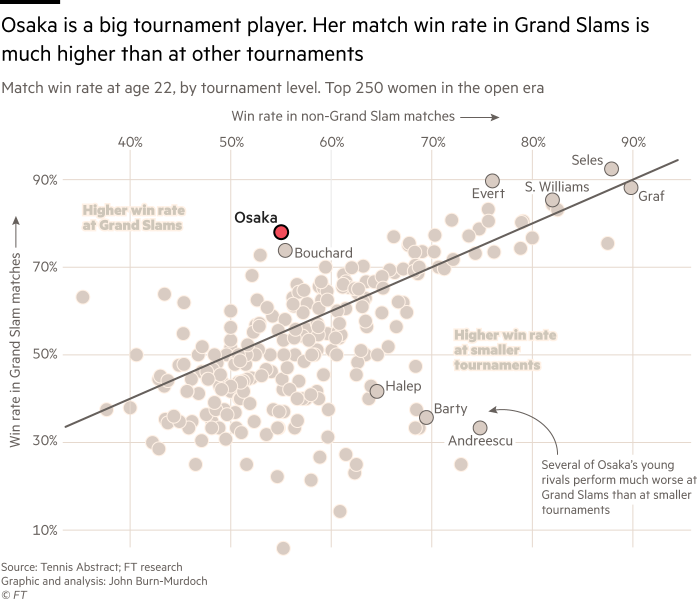
Since winning her second Grand Slam, the Australian Open in January, Osaka has yet to triumph in one of the lesser WTA tournaments this year. (If results go against her in Rome this week — after FT Weekend Magazine went to press — she could even lose her Number One ranking.) This could simply be a regression to the mean. But an analysis of Osaka’s record leads to a different proposition: uniquely suited to serving up her best performances under the strain of the sport’s toughest challenges, she is a big-game player.
Osaka’s father, Leonard Maxime Francois, is Haitian by birth, and moved to Sapporo in Japan in 1990, becoming one of the few black men to live in the northern city. There he met Tamaki Osaka but, in a racially homogeneous nation, the couple kept their relationship a secret. When they decided to marry, it was over the objections of Tamaki’s father. The couple moved south to the city of Osaka, where they had two daughters, Mari and Naomi.
In 1999, Leonard watched on television as two young sisters, Serena and Venus Williams, began their domination of tennis under the tutelage of their father, Richard. Leonard envisaged a similar future for his daughters. A year later, when Naomi was aged three, the family moved to Long Island in New York state. Both girls would follow a strict regime of school and relentless tennis.
![Osaka serving against Serena Williams during the final of the US Open, which she won in straight sets. Asked how it felt playing in the biggest match of her career, she says: ‘I [didn’t] really notice the crowd. It [was] kind of dialled down. When I watch the match back, I hear it more than I did when I was playing.’](https://www-ft-com.ezp-prod1.hul.harvard.edu/__origami/service/image/v2/images/raw/http%3A%2F%2Fcom.ft.imagepublish.upp-prod-eu.s3.amazonaws.com%2F681de5d0-770c-11e9-be7d-6d846537acab?source=next-article&fit=scale-down&quality=highest&width=700&dpr=1)
“I didn’t know anything else,” says Osaka. “During summer vacation all the kids would be talking about the places that they went but I just remember I was practising all day, the entire vacation. So, I would be kind of sad. I was like, ‘I want to go to the pool too.’” Such resentment did not last long though, “because I really wanted to be good when I grew up”, she says.
When the girls were in their early teens, Leonard made the pivotal decision that they would represent the country of their birth rather than the US. Unwittingly, the decision has probably multiplied Osaka’s potential earnings. The Japanese men’s tennis star Kei Nishikori is ranked sixth in the world but has yet to win a Grand Slam. Still, he is the world’s third-highest-paid tennis player, thanks to sponsorship from Japanese companies, meaning he earns more than illustrious counterparts such as Novak Djokovic and Andy Murray.
Osaka has also gained a long list of Japanese sponsors. Her image is used in advertising for All Nippon Airways, Shiseido beauty products, Nissan cars, Citizen watches, Yonex racquets and Nissin instant noodles. This commercial obsession is only likely to grow with the onset of next year’s Olympic Games in Tokyo, where she will be the most globally recognised Japanese athlete and one of the host nation’s best medal hopes. (When I joke whether Osaka is aware of next year’s Games, she quips: “Oh I know . . . The Japanese media have been asking me [about the Olympics] for, like, four straight years.”)
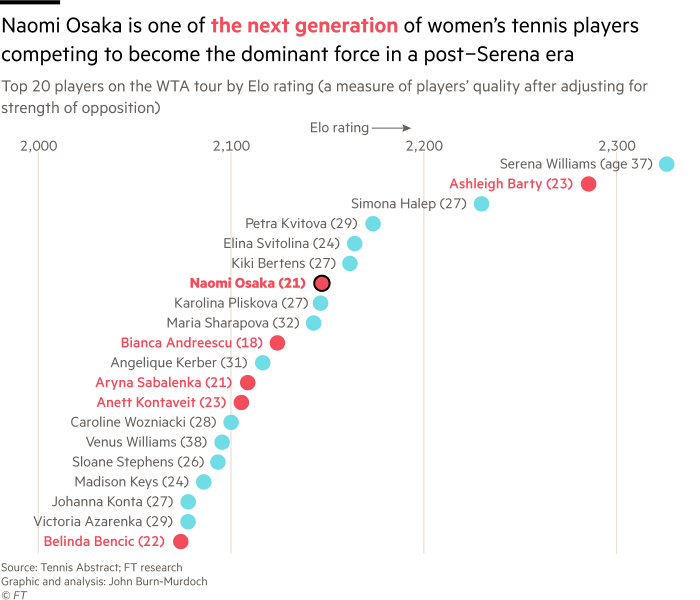
Osaka’s recent Grand Slam wins have given her global prominence. Last month, she signed a deal with Nike in her biggest commercial partnership to date. The US sportswear group is creating a unique logo for Osaka, will allow her to help design her tennis outfits and plans to create a special streetwear clothing line in her name. Nike reserves this kind of treatment for its most prized assets such as Federer and basketball player LeBron James.
Stuart Duguid, Osaka’s agent and an IMG executive, says she resonates with fans across all time zones. “She’s multicultural, multinational, multiracial,” he says. Osaka also represents a new generation in Grand Slam tennis. She is fluent in emoji, a social media-literate fan of pop music and Pokémon. In a recent Instagram post, Osaka used a childhood picture of her and her sister, each striking poses wearing all-body tracksuits, alongside a lyric from a Beyoncé song: “We got the swag sauce, we dripping swagu.”
“We went to the Coachella music festival a couple of weeks ago, and probably half the crowd recognised her as an athlete and the other half, they knew she was a celebrity but they didn’t know where they’d seen her from,” says Duguid. “They thought she was a model or an influencer. She has that X factor that is very intriguing.”
Osaka says that the only identity that matters to her is that of professional tennis player. “I knew that when I was five or six,” she says. “That’s the thing that wasn’t a question. I wasn’t playing to go to college. That wasn’t my end goal. My end goal was to be one of the people that I saw on TV.”
Aged 16, she beat her older sister for the first time (Mari also plays tennis professionally but mainly in less high-profile “challenger” events and is ranked 338 in the world). Soon after, in her first match on the main WTA tour, Osaka caused a stunning upset by beating Samantha Stosur, then one of the world’s best players. “I just remember thinking, like, maybe I have a chance at this,” she says.
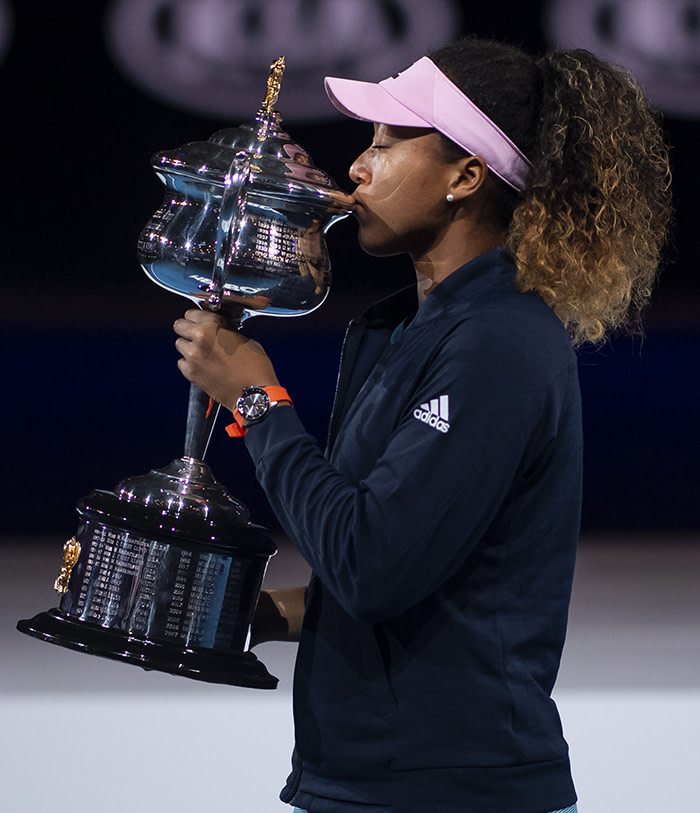
Her break-out match was the US Open final last September, where she faced her childhood heroine Serena Williams. Osaka was playing for her first Grand Slam title. Williams has a record 23 of them. The match is remembered most for Williams becoming embroiled in a heated row with umpire Carlos Ramos, who issued a series of penalties that effectively handed the match to Osaka. The New York crowd booed during the trophy presentation. Osaka hid her face under a visor to mask tears. She even apologised to the audience for her victory.
Few recall that, before Williams’s meltdown, Osaka was dismantling the veteran champion. Like Williams, Osaka has a power game, regularly serving at over 120 miles per hour, one of the fastest in the women’s game. Her other chief weapon is a fearsome forehand. But in recent years, she has developed a more reliable backhand, allowing her to grind out long rallies and wait for the best moment to attack.
When I ask her to explain how her game has evolved, she says: “One of the biggest things was getting fitter, being more physical. I think that’s helped me a lot because it makes me think I would win in three sets if I wanted to and, in turn, that’s sort of chilled me out. I’m not as tense and it doesn’t make me . . . pull the trigger too soon.”
Suddenly, Williams was facing a more complete player than she had faced in many years. But Osaka also has rare mental fortitude. Asked to recall how it felt playing in the biggest match of her career, she says: “I don’t really notice the crowd. It’s kind of dialled down, actually. When I watch the match back, I hear it more than I did when I was playing. I just focus on the court and the other person and what I want to do and what I want to accomplish at that moment. Every other sense is sort of useless.”
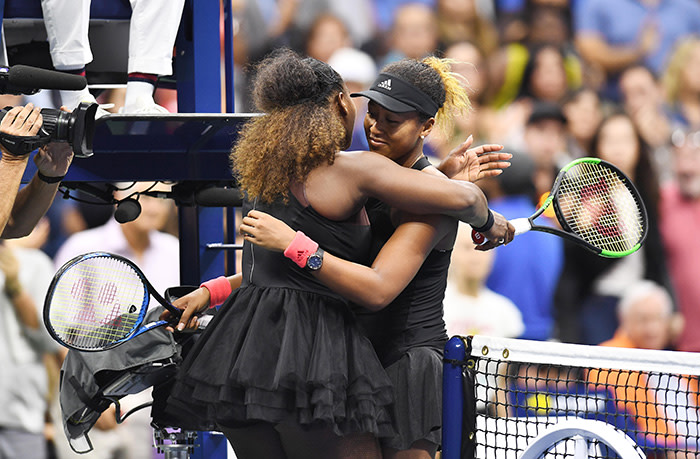
Other top sportspeople describe this as being “in the zone”. The sensation has been studied by US psychology professor Mihaly Csikszentmihalyi, who has produced the seminal research on what he describes as “flow” — a state of “optimal experience” where focus is total, actions become effortless and time seems to slow down. While others may choke on the big occasion, Osaka appears to possess the mind to excel.
“I feel like the Grand Slams are the moments that I saw as a kid,” she says. “It feels different, like, the air is different when you go to a Grand Slam. It feels a little bit more electrifying I guess. And just more fun.”
This is borne out by her record. She has won 78 per cent of all her Grand Slam matches — the 15th-highest win record among the thousands of women to have played during the “open era”, which began in 1968 when professionals were permitted to compete in the Grand Slam events. Those with a better record are among the greats of their respective generations; Williams, Chris Evert, Steffi Graf and Martina Hingis.
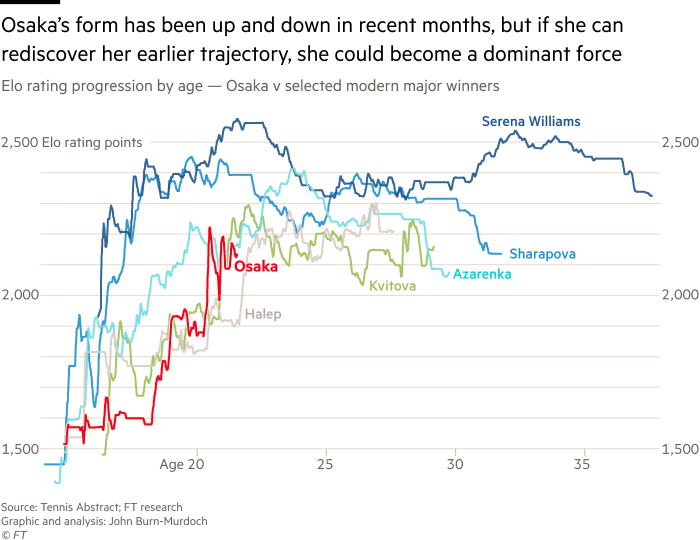
Osaka doesn’t get in the zone as easily during lesser tournaments on the WTA Tour, where her win percentage is lower than the more important Grand Slams. “I’ve never been Number One and a lot of people were talking about it and I think I let it get to my head a little bit,” she says of the defeats she has suffered since winning the Australian Open in January. “Just, like, when you’re Number One you’re not really supposed to lose. At least, that’s how I feel. Of course, people lose all the time. But I just felt like I should at least win a tournament every month or something.
“I know that’s crazy but I was like, you know what, if Federer can do it, I can do it. It’s not even outside pressure, just pressure from myself, and sometimes it helps me play very well. Other times it just makes me overthink. [It is] sort of a battle between those two.”
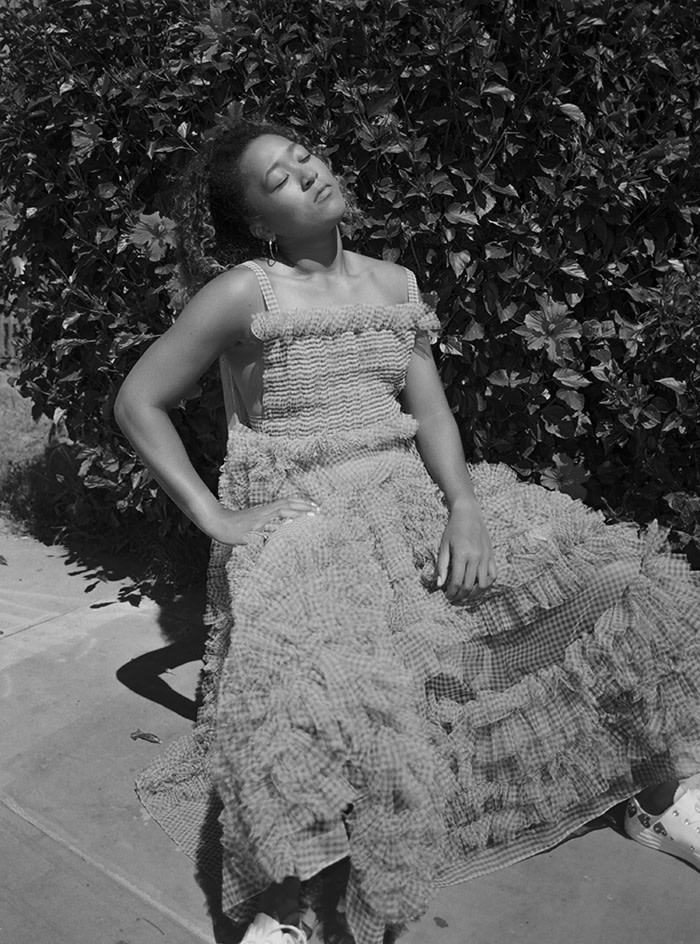
It is inherently difficult to predict the trajectory of an athlete’s career at such a young age. But Osaka knows that to gain the respect of her opponents, so they clear a path for her, she must win relentlessly. At the next tournament. At the next Grand Slam, the French Open, which takes place this month. At Wimbledon in July. The Olympics next year. Again. And again.
Only then will her ambition be sated. Osaka wants to win so much that her opponents stop contemplating victory. “I’m thinking if I can say something, but it’s a really bold statement. I’m debating whether I say it or not,” she says, pausing. “I’m just going to say it. OK, so you know when Serena was Number One? Basically, everyone knew that everyone else had no chance. I kind of want myself to be like that in the future . . . I don’t want to change who I am as a person but I want to be more unapproachable, at least in the locker room. I don’t want to be fluffy.”
Murad Ahmed is the FT’s sports correspondent
The French Open begins on May 26
Follow @FTMag on Twitter to find out about our latest stories first. Subscribe to FT Life on YouTube for the latest FT Weekend videos
This article has been amended to include the fact that Kei Nishikori, the Japanese tennis player, competed in the 2014 US Open final
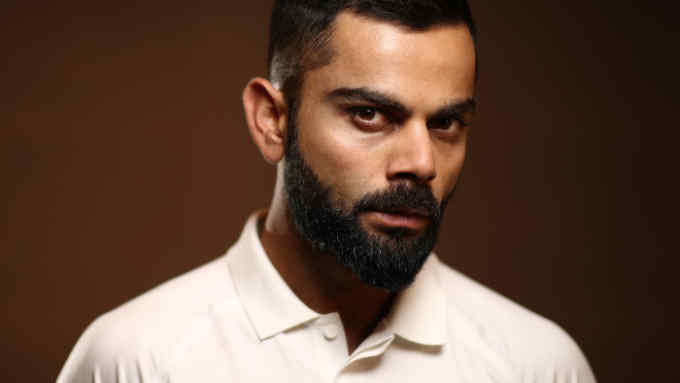
Comments